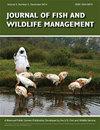三色黑鸟群落多种发声的手动与半自动生物声学分析方法
IF 0.9
4区 环境科学与生态学
Q4 BIODIVERSITY CONSERVATION
引用次数: 0
摘要
生物声学监测可以揭示动物行为的各个方面,因为许多物种的发声与某些行为有关。尽管如此,由于缺乏发声与行为之间关系的知识,以及高效分析捕捉相关行为所需的大型声学数据集的挑战,生物声学仍然很少用于监测动物行为。以前已经为殖民地三色黑鸟Agelaius tricolor建立了发声和相关行为,但对声学数据的有效分析仍然是一个挑战。以前对三色黑鸟声学数据的研究依赖于手动收听录音,这在大范围内是不实用的。使用软件自动检测感兴趣的发声有可能减少分析时间。然而,自动检测容易出现错误,通常是由微弱的声音、重叠的呼叫和背景噪声引起的。因此,结合声学数据集的手动和自动分析的组成部分仍然至关重要。为了应对这些挑战,我们从2019年到2021年在三个三色黑鸟群落部署了自主记录单元,并使用手动和半自动分析方法分析了声学数据。具体来说,我们使用三色黑鸟的雄性鸣叫、雄性合唱、雌性鸣叫、孵化时的鸣叫、筑巢时的鸣叫和初出茅庐时的鸣叫来确定每个群体繁殖阶段的大致时间和繁殖尝试或脉冲的数量。我们发现,使用半自动化方法比手动分析更节省时间,同时使用可比较数量的记录并从菌落中获得等效信息。对于较微弱的发声和具有高背景噪声的菌落,使用半自动方法正确检测发声的几率通常较低。总体而言,半自动化方法具有可容忍的召回率、准确率、假阳性率和假阴性率。我们的方法增加了越来越多的关于声学分析的文献,特别是对于殖民地物种,以及繁殖酚学问题很重要的地方。本文章由计算机程序翻译,如有差异,请以英文原文为准。
Manual Versus Semi-Automated Bioacoustic Analysis Methods of Multiple Vocalizations in Tricolored Blackbird Colonies
Bioacoustic monitoring can reveal aspects of animal behavior as many species vocalize in association with certain behaviors. Despite this, bioacoustics remain infrequently used to monitor animal behavior due to lack of knowledge of how vocalizations relate to behavior and the challenge of efficiently analyzing the large acoustic datasets necessary to capture relevant behaviors. Vocalizations and associated behaviors have been previously established for the colonial tricolored blackbird Agelaius tricolor, but efficient analysis of the acoustic data remains a challenge. Previous work with tricolored blackbird acoustic data relied on manually listening to recordings, which is not practical on large scales. Using software to automatically detect vocalizations of interest has potential to reduce analysis time. However, automated detection is prone to errors often caused by faint vocalizations, overlapping calls, and background noise. Thus, incorporating components of manual and automated analysis of acoustic datasets remains essential. To address these challenges, we deployed autonomous recording units at three tricolored blackbird colonies from 2019 to 2021 and analyzed acoustic data using a manual and a semi-automated analysis method. Specifically, we used tricolored blackbird male song, male chorus, female song, hatchling call, nestling call, and fledgling call to determine the approximate timing of breeding stages and number of breeding attempts, or pulses, for each colony. We found that using a semi-automated approach was more time efficient than manual analysis, while using comparable numbers of recordings and obtaining equivalent information from the colonies. The odds of correct detections of vocalizations using the semi-automated method were generally lower for fainter vocalizations and colonies with high background noise. Overall, the semi-automated approach had tolerable rates of recall, precision, false positives, and false negatives. Our methodology adds to a growing body of literature addressing acoustic analysis, especially for colonial species and where questions of breeding phenology are important.
求助全文
通过发布文献求助,成功后即可免费获取论文全文。
去求助
来源期刊

Journal of Fish and Wildlife Management
BIODIVERSITY CONSERVATION-ECOLOGY
CiteScore
1.60
自引率
0.00%
发文量
43
审稿时长
>12 weeks
期刊介绍:
Journal of Fish and Wildlife Management encourages submission of original, high quality, English-language scientific papers on the practical application and integration of science to conservation and management of native North American fish, wildlife, plants and their habitats in the following categories: Articles, Notes, Surveys and Issues and Perspectives. Papers that do not relate directly to native North American fish, wildlife plants or their habitats may be considered if they highlight species that are closely related to, or conservation issues that are germane to, those in North America.
 求助内容:
求助内容: 应助结果提醒方式:
应助结果提醒方式:


